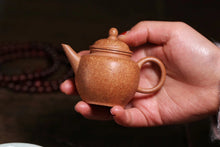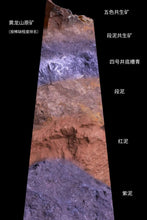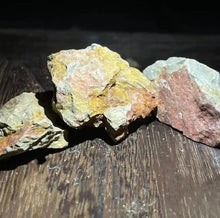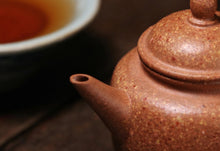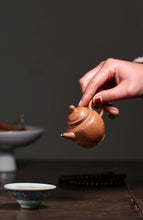
For enthusiasts of purple sand teapots, it's almost a given that they have several cherished teapots at home. The charm of purple sand teapots lies in the infinite variations of their shapes, clay materials, and decorative patterns, offering countless combinations. Moreover, teapots of different heights, widths, and shapes have distinct effects on stimulating the flavor molecules of tea, meaning that even the slightest change can have a significant impact.
In daily life, most purple sand teapots are made from single-type clay materials. Common ones include Zhu clay, Zi clay, and Duan clay, while Tianqing clay and Longxue sand are relatively rare. Different clay materials vary in rarity and firing shrinkage ratio, resulting in different levels of difficulty in collecting and preserving them.
However, in Yixing, the holy land of purple sand, there is an extremely rare type of clay material, which can be regarded as the "epitome" of purple sand clay materials. A single piece of raw ore can integrate five types of clay materials: Hong clay, Lü clay, Jiangpo clay, Duan clay, and Zi clay. This is truly a rare and precious find among purple sand clay materials!
During this trip to Yixing, Tongxin She Teahouse made a great discovery. One of the treasures is Master Hui Xiangyun's "Multicolored Duan Clay Xiangyun Mugugu · Gongju Teapot, 60cc". "Gongju" was a common inscription on purple sand teapots exported to Thailand in the late Qing Dynasty. The styles exported to Thailand in the late Qing Dynasty were basically simple and plain in shape, with exquisite craftsmanship and proper proportions. This teapot has a capacity of 60cc and was meticulously crafted by Master Hui Xiangyun.
Master Hui Xiangyun comes from a family with a long tradition of pottery making. He is the 15th generation descendant of Hui Mengchen, a renowned teapot maker in the Ming Dynasty. Born in Yixing in 1968, he started learning the art of teapot making from his father in his childhood and later became a disciple of He Daohong, a Chinese ceramic art master. With a solid foundation and outstanding craftsmanship, he has a profound understanding of purple sand and is respectfully called the "Folk Purple Sand Master" by collectors. Jin Yong once inscribed "Hui Xiangyun's Precious Purple Sand Ware" for him, and Master Qi Gong personally wrote "Xiangyun Teapot Art, Daring to Scale the Heights".
Since the 1990s, concerned about the possible overexploitation of purple sand ore resources, Master Hui Xiangyun began to vigorously collect high-quality ore resources and was jokingly called the "Old Man Who Hoards Clay" by people in the industry at that time. His works are impeccable in terms of material selection, shape design, and production process. They are exquisitely beautiful without the slightest sign of shoddy workmanship, boasting extremely high artistic appreciation and collection value.
The multicolored symbiotic ore is a rare symbiotic ore among Chinese purple sand ore materials. It refers to ore materials in which different varieties of ores coexist in the same layer structure in nature. It can accommodate five or even more different natural ores within a thickness of about one-inch. This is what can be called a standard multicolored symbiotic ore. Such an ore layer, which is only about one-inch thick or even thinner, containing more than five types of symbiotic ores, is scarce and precious.
Purple sand utensils made from this kind of ore material present a brilliant and magical sand-color effect, with a sense of quaintness and warmth. Looking closely at this clay material, it has a variegated color, rough sand texture, and an ancient quality. It is completely different from the smooth and uniform texture of single-type ore purple sand in the past, showing a kind of primitive simplicity and solid beauty that returns to nature. After getting used to seeing various single-type ore purple sand teapots, looking at this purple sand with a rough sand texture is like traveling through thousands of years and being able to communicate with the ancients.
What's even more special is that after being used for a period of time, this multicolored symbiotic purple sand will naturally form a patina effect, just like a splash-ink landscape painting by a famous artist, which is truly wonderful.
Regrettably, in order to protect the purple sand ore resources, the Yixing government once froze the mining of purple sand ore, making the already rare original ore purple sand even more precious. The price of original purple sand ore has also soared accordingly. As a precious type of original ore, the multicolored symbiotic ore is often available in price but not in the market. Currently, the market price of multicolored symbiotic ore materials is about 180,000 yuan per bundle ,with extremely high collection value.
Such a precious and rare purple sand teapot not only has high collection value but can also enhance the aroma of tea. For tea lovers, it is truly a rare "treasure of the heart". The multicolored Duan clay purple sand teapot has significant advantages when making tea. It can maximally stimulate the aroma of various types of tea, making the tea soup mellow and sweet-aftertaste. Whether it is used to brew fragrant green tea, rich black tea, or fragrant oolong tea, it can bring out the most authentic flavor of the tea. When boiling water is poured into the teapot, the aroma of tea rises. At this time, appreciating the multicolored teapot body is undoubtedly a double-feast for the eyes and taste buds.











